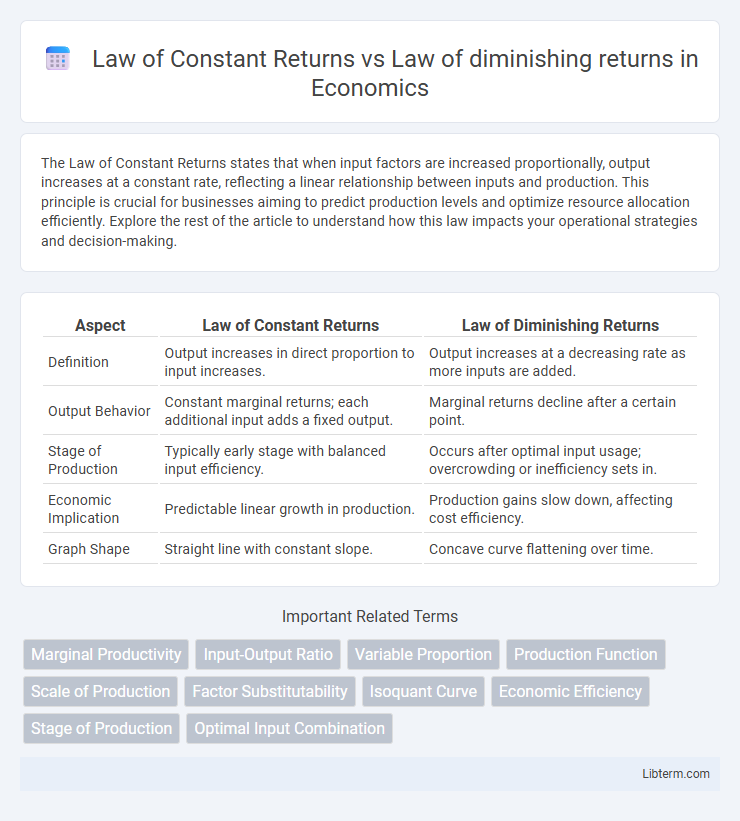The Law of Constant Returns states that when input factors are increased proportionally, output increases at a constant rate, reflecting a linear relationship between inputs and production. This principle is crucial for businesses aiming to predict production levels and optimize resource allocation efficiently. Explore the rest of the article to understand how this law impacts your operational strategies and decision-making.
Table of Comparison
| Aspect | Law of Constant Returns | Law of Diminishing Returns |
|---|---|---|
| Definition | Output increases in direct proportion to input increases. | Output increases at a decreasing rate as more inputs are added. |
| Output Behavior | Constant marginal returns; each additional input adds a fixed output. | Marginal returns decline after a certain point. |
| Stage of Production | Typically early stage with balanced input efficiency. | Occurs after optimal input usage; overcrowding or inefficiency sets in. |
| Economic Implication | Predictable linear growth in production. | Production gains slow down, affecting cost efficiency. |
| Graph Shape | Straight line with constant slope. | Concave curve flattening over time. |
Introduction to the Laws of Returns
The Law of Constant Returns states that output increases proportionally with the input, maintaining a consistent rate of productivity when additional units of a factor are applied. In contrast, the Law of Diminishing Returns describes a point where adding more of a single input, while holding others constant, leads to progressively smaller increases in output. Both laws are fundamental in production theory, illustrating how varying input levels impact total product and efficiency.
Understanding the Law of Constant Returns
The Law of Constant Returns occurs when output increases in direct proportion to an increase in inputs, maintaining a consistent productivity level. This principle contrasts with the Law of Diminishing Returns, where output growth slows despite additional input increments. Understanding the Law of Constant Returns is essential for optimizing resource allocation in production processes without efficiency loss.
Exploring the Law of Diminishing Returns
The Law of Diminishing Returns states that as additional units of a variable input, such as labor, are added to fixed inputs like capital or land, the resulting increase in output eventually decreases. This principle highlights the inefficiency that arises when the capacity of fixed resources becomes insufficient to support extra input effectively, causing marginal productivity to decline. It contrasts with the Law of Constant Returns, where output increases proportionally with input, emphasizing different phases of production optimization in economics.
Key Differences Between Constant and Diminishing Returns
The Law of Constant Returns states that output increases proportionally with input, maintaining a consistent rate of production, while the Law of Diminishing Returns describes a scenario where output increases at a decreasing rate as more units of a variable input are added. Key differences include the behavior of marginal productivity; constant returns show unchanging marginal returns, whereas diminishing returns involve a decline in marginal output after a certain point. These laws impact resource allocation strategies, with constant returns suggesting stable efficiency, and diminishing returns indicating reduced efficiency and the need for optimized input levels.
Factors Influencing Constant Returns
Factors influencing the Law of Constant Returns include the balanced proportion of inputs, where increases in one input are matched by proportional increases in others, maintaining consistent output levels. Technological stability and optimal resource utilization ensure that productivity remains steady without significant gains or losses. Efficient management practices and fixed factor constraints also contribute to sustaining constant returns during production scaling.
Causes and Implications of Diminishing Returns
The Law of Diminishing Returns occurs when increasing one input factor while keeping others constant leads to progressively smaller increases in output, often caused by factors such as limited capacity, inefficiencies, or resource constraints. This phenomenon implies reduced productivity and higher marginal costs, impacting profit margins and operational scalability. In contrast, the Law of Constant Returns indicates a proportional increase in output relative to input, reflecting an efficient production environment without resource limitations.
Real-World Examples of Constant Returns
Constant returns to scale occur when increasing all inputs in production leads to a proportional increase in output, as seen in large-scale manufacturing industries like automotive assembly plants, where doubling labor and capital results in doubling vehicle production. In contrast, the law of diminishing returns describes a scenario where adding more of one input, while holding others constant, yields progressively smaller output increases, common in agriculture when extra fertilizer eventually produces minimal crop yield gains. Real-world examples of constant returns emphasize efficient coordination and scalable processes that maintain productivity proportionality despite expansion.
Real-World Examples of Diminishing Returns
The Law of Diminishing Returns is vividly illustrated in agriculture, where increasing fertilizer beyond a certain point leads to smaller yield improvements, demonstrating reduced productivity per additional input. In manufacturing, hiring more workers in a limited workspace results in overcrowding and efficiency drops, showcasing diminishing marginal gains. Conversely, the Law of Constant Returns implies output increases proportionally to inputs, seen in continuous production processes with consistent technology and resource quality.
Economic Significance of Both Laws
The Law of Constant Returns highlights a phase in production where output increases proportionally with input, ensuring stable efficiency and cost predictability, which is crucial for long-term business planning. In contrast, the Law of Diminishing Returns signals a decline in marginal productivity as inputs increase, emphasizing the importance of optimizing resource allocation to prevent inefficiencies and rising costs. Understanding both laws guides economists and managers in making informed decisions on scaling production, cost management, and maximizing profitability.
Conclusion: Balancing Inputs and Production Efficiency
The Law of Constant Returns states that output increases proportionally with input, maintaining steady production efficiency, while the Law of Diminishing Returns highlights a decline in additional output despite increased inputs, signaling inefficiencies. Balancing these laws requires optimizing resource allocation to achieve maximum productivity without succumbing to diminishing marginal returns. Effective production strategies rely on identifying the point where input increments no longer yield proportional output gains, ensuring sustained operational efficiency.
Law of Constant Returns Infographic

 libterm.com
libterm.com